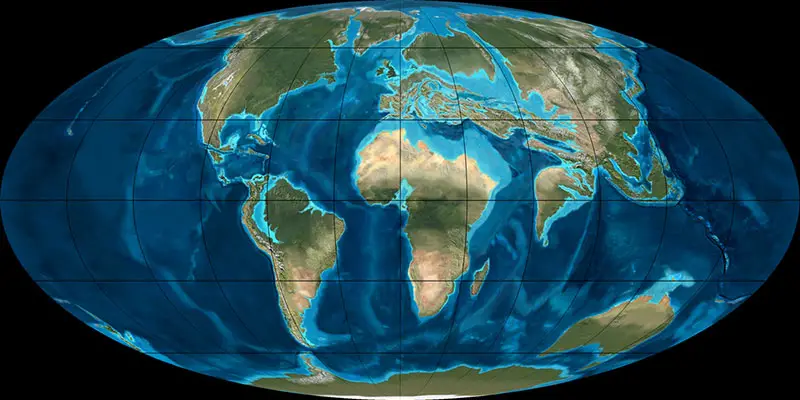†Smilodectes (Notharctidae)
Smilodectes ist eine Primatengattung innerhalb der Familie Notharctidae, deren 4 Mitglieder ab dem frühen Paläogen (Eozän) im Ypresium lebten, das vor ungefähr 56 Millionen Jahren begann und bis vor 47,8 Millionen Jahren andauerte. Viele Überreste wurden in Vereinigte Staaten von Amerika (USA) gefunden.
Smilodectes aus der Familie Notharctidae (Überfamilie Adapoidea innerhalb der Strepsirhini) war im Eozän in Nordamerika verbreitet.
Smilodectes war ein naher Verwandter von Notharctus. Die beiden Gattungen unterscheiden sich generell nur dadurch, dass Smilodectes kleinere, schmalere Backenzähne besaß. Außerdem ist die Schnauze von Smilodectes etwas kürzer als die von Notharctus. In anderen Aspekten der Schädelanatomie und des Skeletts sind sich beide Gattungen aber sehr ähnlich.
Smilodectes gracilis
Das Typusexemplar mit der Bezeichnung YPM 11800 ist der hintere Teil eines linken Unterkieferastes mit einem Prämolaren (P4), einem Molaren (M1) und einem Teil des dritten Prämolaren (P3). Der Fund stammt aus dem Lower Member der Bridger Formation (Uinta County, Wyoming) und ist zwischen 50,3 und 46,2 Millionen Jahre alt.
| Sammlung | Epoche, Alter | Geologie, Formation | Kommentar zur Sammlung |
|---|---|---|---|
| 1375 No.8 | Bridger | B-8 | |
| Physiologie | |
|---|---|
| Gewicht: | ? |
| Schwestertaxa | |
Smilodectes mcgrewi
Das Typusexemplar mit der Bezeichnung UW 5021 ist ein linker Unterkiefer mit Molaren (M1-3) und Prämolaren (P3-4). Die Funde stammen stammen aus der Bridger Formation (Typlokalität: Kistner Locality V-16, Sweetwater County, Wyoming) und sind zwischen 50,3 und 46,2 Millionen Jahre alt. Sie werden an der University of Wyoming aufbewahrt.
| Sammlung | Epoche, Alter | Geologie, Formation |
|---|---|---|
| Big Island-Blue Rim Badlands (UM BI-7) | Bridger | |
Smilodectes sororis
Das Typusexemplar mit der Bezeichnung UM 104807 ist ein Unterkiefer mit rechtem Gebiss, bei dem zwei Backenzähne erhalten sind (M1-2). Der Fund stammt aus der Wasatch Formation (Fremont County, Wyoming) und ist zwischen 50,3 und 46,2 Millionen Jahre alt.
| Sammlung | Kommentar zum Fundort | Epoche, Alter | Geologie, Formation | Kommentar zur Sammlung |
|---|---|---|---|---|
| South Pass (Gardnerbuttean) | Wasatch | Honeycomb Buttes | ||
| Kommentar z. Stratigraphie | Lithographie | |||
| spans upper chron C24n and lower chron C23r: Clyde et al. 2001 | ""thick brown paper shales interbedded with relatively pure carbonate, trona, and gypsum beds" |
Literatur
J. L. Wortman 1903, Studies of Eocene Mammalia in the Marsh Collection, Peabody Museum. Part II. Primates. Suborder Cheiromyoidea. The American Journal of Science, series 4. 16, p. 345 - 368P. Robinson 1957, The species Notharctus from the Middle Eocene. Postilla. 28, p. 1 - 27
R. M. West 1973, Geology and mammalian paleontology of the New Fork-Big Sandy area, Sublette County, Wyoming. Fieldiana: Geology. 29, p. - 27
C. L. Gazin 1976, Mammalian Faunal Zones of the Bridger Middle Eocene. Smithsonian Contributions to Paleobiology. 26, p. 1 - 25
P. D. Gingerich 1979, Phylogeny of middle Eocene Adapidae (Mammalia, Primates) in North America: Smilodectes and Notharctus. Journal of Paleontology. 53:1, p. 153 - 163
L. Krishtalka, R. K. Stucky 1984, Middle Eocene marsupials (Mammalia) from northeastern Utah and the mammalian fauna from Powder Wash. Annals of Carnegie Museum. 53:2, p. 31 - 46
G. F. Gunnell, W. S. Bartels, P. D. Ginberich, V. Torres 1992, Wapiti Valley Faunas: Early and Middle Eocene Fossil Vertebrates from the North Fork of the Shoshone River, Park County, Wyoming. Contributions from the Museum of Paleontology, University of Michigan. 28:11, p. 247 - 287
R. K. Stucky, W. S. Bartels, P. D. Ginberich, V. Torres 1994, Personal communication regarding identifications of Eocene mammals. . :11, p. - 287
W. C. Clyde, J.-P. Zonneveld, J. Stamatakos, G. F. Gunnell, W. S. Bartels 1997, Magnetostratigraphy across the Wasatchian-Bridgerian boundary (early to middle Eocene) in the western Green River Basin, Wyoming. Journal of Geology. 105:11, p. 657 - 669
G. F. Gunnell, J.-P. Zonneveld, J. Stamatakos, G. F. Gunnell, W. S. Bartels 1998, Mammalian Fauna From the Lower Bridger Formation (Bridger A, Early Middle Eocene) of the Southern Green River Basin, Wyoming. Contributions from the Museum of Paleontology, University of Michigan. 30:3, p. 83 - 130
G. F. Gunnell, W. S. Bartels, J. Stamatakos, G. F. Gunnell, W. S. Bartels 2001, Basin margins, biodiversity, evolutionary innovation, and the origin of new taxa. Eocene biodiversity: unusual occurrences and rarely sampled habitats (G. F. Gunnell, ed.). :3, p. 403 - 432
G. F. Gunnell, W. S. Bartels, J. Stamatakos, G. F. Gunnell, W. S. Bartels 2002, Notharctine primates (Adapiformes) from the early to middle Eocene (Wasatchian-Bridgerian) of Wyoming: transitional species and the origins of Notharctus and Smilodectes. Journal of Human Evolution. 43:3, p. 353 - 380
J. Alroy, W. S. Bartels, J. Stamatakos, G. F. Gunnell, W. S. Bartels 2002, Synonymies and reidentifications of North American fossil mammals. . :3, p. - 380
M. Spaulding, J. J. Flynn, R. K. Stucky 2010, A new basal Carnivoramorphan (Mammalia) from the ‘Bridger B’ (Black’s Fork member, Bridger Formation, Bridgerian Nalma, middle Eocene) of Wyoming, USA. Palaeontology. 53:4, p. 815 - 832, DOI: 10.1111/j.1475-4983.2010.00963.x
